|
The mainsail has a very important role to play in the development of power from the whole rig. This stems not only from its function as the windward part of the slot between genoa and main, but also from its sheer size. Correct setting up and control are therefore necessary to get the most speed out of the sail. Particular care has to be taken with the mainsheet tension because it is very easy to oversheet and stall the air flow coming off the leech. This usually occurs when beating or reaching. So do remember that as the air flows over the sail’s windward and leeward surfaces, it forms a pressure gradient which creates a leeward going force at right angles to the sail’s surface. Obviously the bulk of this force is in the leeward front sections of the sail, but if the leech is too tight, some of it will actually be facing backwards to create drag. This not only decreases forward movement but increases sideways and heeling forces. In such a case, the leeward air will refuse to conform to the sail’s exit curve. As the lee-ward air flow breaks away, the sail stalls, resulting in a dramatic loss of power and speed. This explains that sudden loss of speed in fluky or gusty conditions when the sail cannot cope with the variations in the speed of the air flowing across it, and it explains why rigs must be capable of adjustment. The golden rule for setting the Wayfarer mainsail is that the sail will be set correctly if the aft 6” or so of the top batten and the last two feet of the boom are parallel. As everything else is subservient to this essential condition, the sailors have to organize mast bend as well as sheet, vang and foot tension to suit. The sail should therefore be set up to have the proper shape in middle wind conditions with rig variations built in to enable to sail to adjust to lighter and heavier winds. Force 2 -3 (4 - 10 knots) is about the optimum. It is in those conditions that most crews will be sitting to windward without being over- or under-powered, and the sail should be at its fullest in these conditions. As the wind rises, the sail has to be flattened - or more correctly, feathered - to reduce the heeling force. As the wind drops, the sail has to be flattened again, albeit in a different way, for the weak, slow moving air tires as it flows over the sail. The way to flatten the sail in either condition is to make it wider by bending the mast. This drags fullness from the body of the sail. Obviously, this flattening must not be done too early so that the sail loses power and the crew have to sit in, or too late so that the boat heels over and slows down. In simple terms, if you are having to spill wind earlier than other boats with similar crew weights, and if you are very, very fast off the wind, yet very slow to windward, then your mast is probably not bending enough. If, on the other hand, you are not sitting out as early, or are going very slowly off the wind, then your mast is likely bending too much. The aim has to be to get both helm and crew sitting out as soon as is possible, whilst delaying by as much as possible, the moment when the helm has to start feathering the mainsail. In force 2-3 (5-10 knots), a mast rake of 23’5½” to 23’6 ½” recommended. This is measured {onshore) in the straight line from the masthead black band to the centre of the main sheet traveller (its lower forward edge). There should also be 330 -350 lb. of rig tension on the windward shroud. (Al’s note: The mast needs to be pinged into its pre-bend position before this measurement is taken - see paragraph on pre-bend later in this part of the article. On W3854, we simply measure the rake by 1. hoisting the jib and tensioning the
rig for medium winds
As the wind increases, the rake will need to be increased (i.e. distance between black band and traveller shortened!) to make it easier to keep the boat tramping fast. This technique has been incredibly successful in the Olympic classes, and is now being increasingly used in all classes. The reasons for its success are rather obscure, but could include opening the slot between genoa and mainsail, making the leech of the remain more open, and making the leech of the main more vertical. Whatever the reason, it works - particularly for light weight crews. Care has obviously to be taken not to overdo things, because on the Wayfarer, increased rake has to be pre-set by moving the lower end of your shrouds down 1-2 holes in your shroud plates. The trouble is of course, that if the wind drops and you have extra rake, you will go more slowly. To sum up, if the wind is going to be strong, reducing the distance from black band to traveller by 2-4” can help enormously. Rig tension should also be increased to something like 350-360 lb.. By the same token, increasing the distance by 1-2” and decreasing rig tension to 300-330 lb. as the wind gets lighter gives a better feel to the boat. It is obviously important to make sure that the mast is actually upright and as near the centre line as possible. If it is not, the slot between genoa and main will vary, the spreaders will be hard to organize, and the shrouds will have differing tensions. Measure to each corner of the transom from the mast head by tying a tape measure onto the main halyard. Also check the distances to the shroud anchorages. If the top of the mast is leaning one way or the other, then the mast gate has to be adjusted as a last resort. Once the mast is vertical and straight, move on to controlling the bend. The basic principle is that once the spline (vertical) strength of the mast has been overcome, it will start to bend and very little extra load is needed to keep it bending. Thus, bend is not that difficult to organize. The mast needs to be bent in light winds, then straighter in middle airs (to make the crew work hard), and finally the mast has to bend again as the main sheet is eased to feather the main. This time of course, it has to act as a spring in the system so that every time a gust hits the rig, the helms-man will have time to ease the main sheet out and feather the main before the boat heels over. If the boat violently heels instantly the gust hits, and before the main sheet can be eased, then the mast is too stiff and the sail too full. If on the other hand, the gust passes by without showing any real signs of heeling the boat and the main sheet does not have to be eased, then the mast is too bendy. The mast must be made to bend progressively when required and not before. To start with, the mast has to be a tight fit sideways in the mast gate at deck level. This must be checked from time to time as there is a considerable load here and the gate gradually wears. Tiny amounts of movement here give amazing amounts higher up. For instance, a quarter of an inch of play at the gate will produce over two inches of movement at the spreader tips, making a mockery of any deflections here. There should however, be a gap in front of the mast, which can be filled as necessary to stop it bending forward. If chocks are fitted, they work well but are limited in that they have to be set up before the race. It is obviously best to have several small chocks rather than one large one. Mark the deck where the front of the mast comes to, and then fit chocks in front, completely filling the gap. Hoist the sails in a medium breeze. With the genoa in its correct beating trim with all windtufts working together, sheet the main in. A small amount of backwinding is normal, but if the whole luff area is really backing, then remove a chock to allow the mast to bend more until backwinding is reduced to an acceptable level. This then becomes the starting position. From then on, ex-periment with taking chocks out as the winds gets up, taking out just enough to keep the crew sitting out. Remember that with the mast rammed hard against them, chocks are impossible to release, and tension must be released from the spar, either to get more in or to take some out. Unfortunately, they can get lost overboard unless threaded with thin cord. So, in light winds (crew to leeward) there should be no chocks. Maximum chocks in medium air as long as the crew can handle the power by sitting out and keeping the boat flat. Remove chocks as soon as the main sheet has to be eased out. Perhaps the single most important aspect of setting up the Wayfarer rig is that the mast should have about 1½” of pre-bend at the spreaders. This is created by rig tension and by a forwards thrust of the spreaders. Unfortunately, rig tension is loaded by tensioning the genoa halyard. This pulls the top of the mast forward - in fact the reverse of pre-bend. Fortunately, the Wayfarer sailor can easily reverse this bend by standing in his boat and pushing forwards on the mast as high as he can reach. The mast will then ‘ping’ into a pre-bend position. For the midd-le of the mast to go forwards, the heel section below the pivot bolt must come aft. So it is very important that the heel does not come into contact with the step restraining pin until maximum pre-bend is on. Otherwise the mast will not be able to pre-bend sufficiently. The heel of the mast should however come up against the restraining pin with full pre-bend on. Otherwise there is a chance that the heel plug of the mast can be levered out of the mast step track. This is particularly important for Wayfarers with the genoa halyard led back along the centreboard box. Pre-bend is in fact easier to produce if the halyard is led aft, because then the bottom of the mast (below the pivot) is pulled aft as the halyard is tensioned. Therefore, for those Wayfarers using mast-mounted tensioning devices, it may be necessary to angle the spreaders slightly further aft to create an equal amount of bend. The idea behind pre-bend in light winds is to flatten the sail to ease the leech and to give a shallow angle of attack. Using the vang and mainsheet to bend the mast would be unsatis-factory since this would tighten the leech and the tired, slow air then cannot open it out. Thus, even if the front (angle of attack) is flattened, the overall arc (curve) in the sail is not reduced. Once the breeze gets up, it is the forward thrust of the boom at the gooseneck which provides the best means of bending the mast. The vang and the main sheet both create this thrust although they have rather different effects on the mainsail. Main sheet tension primarily tightens the leech before bending the upper mast. This not only ruins the top batten/ boom relationship but also does little to open the slot, causing congestion and backwinding when the main is eased out in gusts. The disadvantage in this system is most obvious in gusty conditions where the mainsail needs to be constantly played in order to keep the boat upright. As soon as the sheet is eased, tension is reduced and the upper sail becomes fuller. This increases its heeling force at the very moment when there is more wind about - the very opposite of what is needed. Even worse is the time lag if a centre main jammer is used which may well be under considerable load. The teeth of the jam cleat are often so well dug into the rope that it takes real brute force to tear it out. By this time, the water may already be pouring over the leeward side deck. With aft main sheeting the task becomes downright impossible. The job of forcing the boom forwards has to be the job of the vang. By its very angle (hopefully 45º to both mast and boom, it exerts a forward as well as a downward force. This means that it does much to flatten the lower sections of the main which helps to cut down backwinding in the area of the slot. Not only that, but the mainsheet has very little weight on it and can concentrate on its main job of positioning the boom at the proper angle to the centre line. Vangs have therefore become very much more powerful in recent years. Winches and levers are being replaced recently by multi-purchase roller bearing blocks. It is very important that the controls be lead aft to the helmsman on both sides of the boat. This takes some thought as the Wayfarer was unfortunately designed before split controls, etc. were thought about. As the power of the vang increased, the need for a main sheet traveller declined. A decline that has been heightened by the trend towards mainsail twist. Remember that easing the leech of the mainsail, especially in light winds, means it can react to the air flow by opening and shutting according to the pressure of the horizontal air rather than the vertical tension of the vang and the mainsheet. (Al’s note: Mike points out that Ian Porter has not entirely abandoned the traveller which seems to help him in a breeze. I have a similar note from Ian to that effect. He states that he uses a bridle in light airs and the traveller in a breeze.) As this technique was being developed, it became apparent that it was necessary to copy the successful close sheeting genoa jib idea and bring the boom in towards the centre line. This then stopped the upper leech from opening out too much and feathering. In fact this move led to the decline of the main sheet traveller because using the traveller made it necessary to oversheet the mainsail to stop the boom from sagging off to leeward. This in turn overtightened the leech and stalled the mainsail. Thus, Wayfarer sailors have recently been encouraged to abandon the mainsheet traveller altogether and to cut down on the boom’s sideways sag by raising the transom block to-wards the boom blocks. By fitting strops to each quarter, one forms a triangle that results in very little downwards load on the end of the boom. So it is easy to bring the boom in without tensioning the leech. Interestingly, this system can also be used if aft mainsheeting is used. This strop system is perhaps at its most vulnerable in very strong breezes when the conventional traveller slider can be eased slightly away from the centre to help feather the main. It may also give difficulties on close reaches where a slider can go right out to the quarter and help to keep the leech tight. If an aft mainsheet system is used, then a jam cleat should be fitted on the aft deck somewhere. The sheet can then be cleated when raising or lowering the spinnaker. If centre sheeting is used, then small loops should be fitted to the underside of the boom for the sheet to run through. Otherwise the helm will be garroted on the gybe. The centre main jammer itself should be easy to uncleat -especially on gusty days! The helm should not have to make undue effort to uncleat (i.e. raise his arms too high in the air). Another vital control, especially with the current trend towards close sheeting genoas, is the ability to adjust tension along the foot of the mainsail so that the bottom section of the sail can be flattened to keep the slot open. In fact, it is all too easy to overflatten the bottom of the sail. So, initially have the foot fuller than you think is necessary. Then, as the front of the sail backwinds, flatten progressively until there is as little backwind as possible. This also gives the advantage of opening out the lower leech to reduce heeling forces. In simple terms therefore, when beating in light weather, the foot should be as tight as possible with horizontal ridges. As soon as the crew sits on deck, the sail should be eased about 1½” to give some backwinding but not too much. Then, as the helmsman has to progressively ease the main sheet, the foot should be tensioned gradually to cut down the heeling moment. Do remember however, that if there isn’t power in the rig to drive through waves, it pays to have the foot fuller and to accept the backwinding. Finally, mark the control line where it leaves the boom to show the amount of tension applied, and lead it back to the helmsman. We now come, at last, to the best way of controlling mast bend - the proper organization of the relationship between mast, spreader and windward shroud. This means that by adjusting our support of the (inherently) bendy middle of the mast via the spreader, we can create bend or stiffness at will. This control of the spreaders is necessary
for three very important reasons:
The key to correct spreader setting is, of course, the windward shroud. As this is holding the rig up, it is under considerable loading. Thus a great amount of control can be exerted over the mast by connecting it to the shroud by means of the spreader. Control of fore and aft bend is the responsibility of the fore and aft position of the spreader tip (at the shrouds) and its relationship to the spreader root (at the mast). If the tip is well behind the root, the shroud is kinked aft. Under load, it naturally tries to straighten, thus pushing both the spreader and the mast forward, and creating mast bend. On the other hand, if the spreader tip is positioned so that it causes the shroud to kink forward, both the spreader and the mast will be pulled aft as the shroud tries to straighten under load, thus inhibiting bend. Sideways bend (created by the diagonal forward thrust of the boom) is controlled by the spreader length. The longer the spreader, the greater the angle that the shroud makes where it enters the mast at the hounds. The greater that angle, the stiffer the topmast. Also, the longer the spreader, the more the shroud is pushed sideways out of the straight line. As the shroud comes under tension and tries to straighten, it pushes against the spreader and hence against the mast. There is a danger that if the spreader is too long, the mast can actually be pushed past the straight line and bend to leeward. This not only closes the slot by pushing the main towards the jib, but also makes it impossible for the air to conform to the mainsail’s leading curves. Obviously this is more likely to happen in light airs when the vang is not so loaded and when the boom is amidships. A good point from which to start in Wayfarers is to have each spreader 1’8” long and to fix the spreaders so that the tip to tip distance (Al’s note: we measure this from shroud to shroud) across the back of the mast is 3’2”. To find out whether the spreaders are doing
their job correctly, there are three simple guides:
The second guide concerns the way the sail fits the mast. Any sail will crease when the mast bends so much that the leech is pulled into the belly of the sail. As the mast bends there is also a shortening of the distance between the black bands on the mast. If the luff curve fits the mast bend, the creases will disappear when the cunningham is tensioned. Failing this, the luff curve and mast bend obviously do not match. The point where any persistent creases, if extended, would reach the mast, is the area of incompatibility. By standing in front of the boat, one can easily see why the creases are there. The leeward curve in the fullness is not fair, and there will be a distinct change in the profile. This marks the changeover point between the area where the luff curve is being used up by the mast bend and the area where the luff curve is not being used up. The sail is either too flat above, or too full below the line. 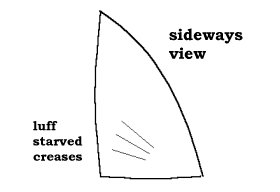 ..... .....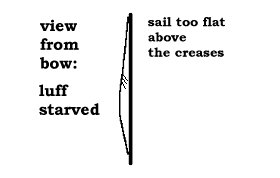
..... 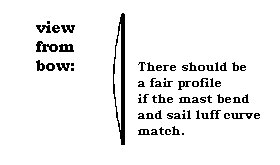
..... 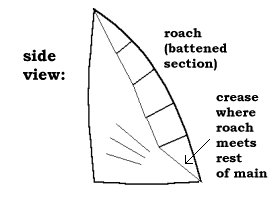 ..... .....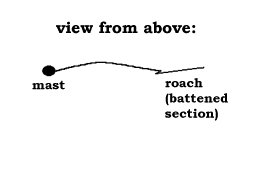
..... Experimenting with the mast is best done outside the race situation. In the race itself, too many things are happening, making it impossible to concentrate on the work that the spreaders are doing. Try differing rigging tensions, because the slacker the rigging, the less work the spreaders will do. If possible, try to see your boat from outside to calculate from a distance, the effect of these changes. Wind tufts should be fitted to leech of the main. The idea is that they should stream aft on a properly set and trimmed main sail. If they bend round to the leeward side of the sail, the air flow on that side has broken down because the leech is too tight. So ease the vang and/or the mainsheet. If they bend round to windward, the leech is too slack and the vang and/or mainsheet need to be tightened. Beware however, of watching the windtufts too slavishly. In fluky conditions, they can be too twitchy. One very important guide to leech tension is that the whole mainsail luff should backwind at the same time. If the upper luff backwinds first, the leech is too slack. Finally, the job of the cunningham is to provide extra tension to the luff when the mast has been bent and the distance between the black bands thus reduced. It must not be over-tensioned. Otherwise a vertical ridge is created behind the luff and the leech is opened out. The correct way to use the cunningham is to bend the mast with the vang and/or main sheet to get the top batten and boom in proper alignment, and then to tension the cunningham sufficiently to remove any luff creases. If in doubt, leave well enough alone and accept the creases. The golden rule is: vang on and, if you have time, cunningham on, but if the vang is eased, the cunningham must be eased, whatever else happens! SUMMARY OF KEY MAINSAIL RELATED MEASUREMENTS: Mast Rake: 23’5½”-23’6½”(measured from mast head black band to underside of mainsheet track in centre of tiller port with the rig under 330 lb. of tension and the mast pre-bent) Spreader Length: 1’8”(measured from mast) Spreader Deflection:3’2”(measured in straight line between tips) |